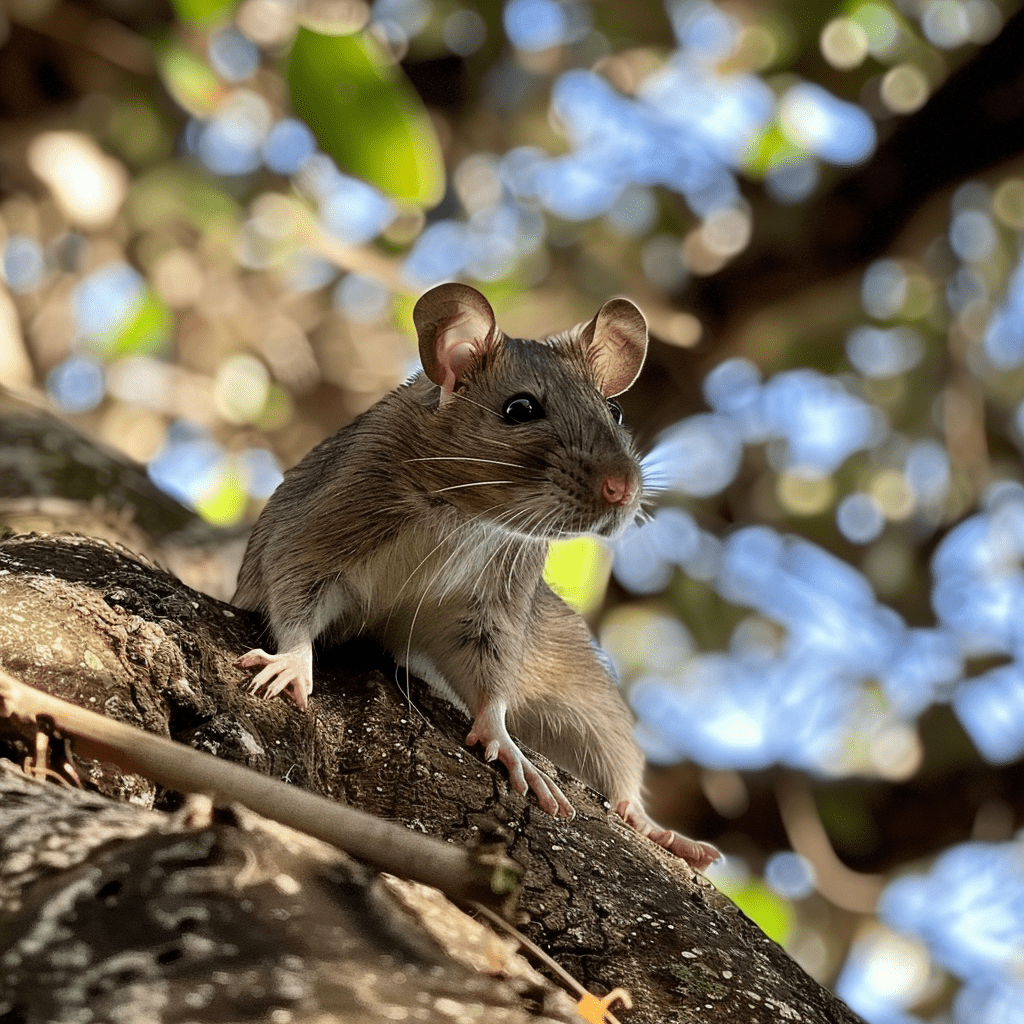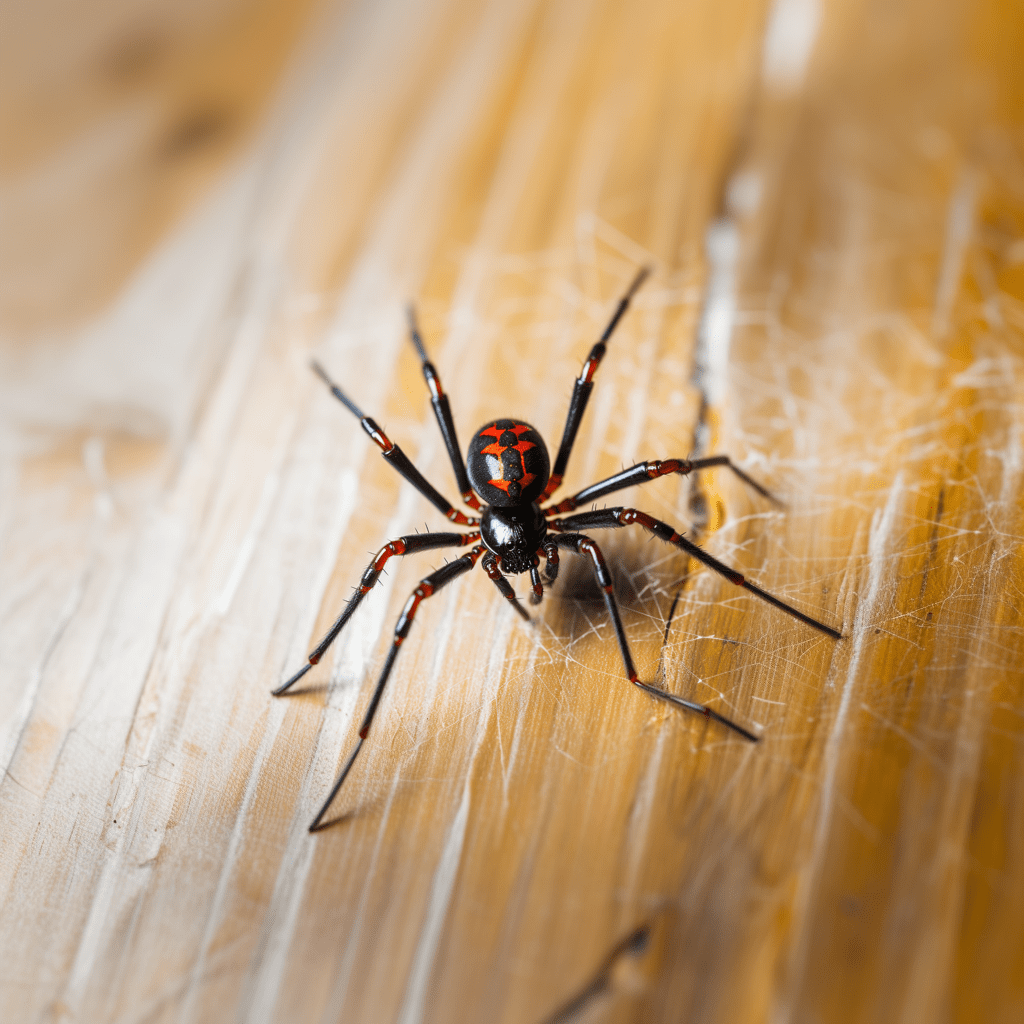
Table of Contents
Imagine a quiet evening on your patio, the Florida sun setting, casting a warm, orange glow across your backyard. Suddenly, your tranquility is shattered by the sight of a black widow spider lurking in the corner. These arachnids, notorious for their venomous bite, are a common sight in Florida homes, turning serene moments into heart-pounding encounters.
Key Takeaways
- Black widow spiders, recognizable by their shiny black bodies and red hourglass-shaped markings, carry venom that is 15 times more potent than a rattlesnake’s, making them dangerous particularly the female spiders.
- Preferring warmer climates, black widows inhabit various environments worldwide, both outdoors and indoors, turning quiet places like woodpiles, storage bins, or garages into potential habitats.
- Even though black widows have unique mating rituals and survival odds against parasitic insects, they manage to continue their species.
- Misconceptions like all black widow spiders being female or their bites being fatal are debunked, promoting a better understanding and the possibility of coexistence between humans and these spiders.
- While anyone can encounter a bite from a black widow, people living or working in regions prone to black widows, outdoors workers, children, elderly, or people with compromised immunity, are at a higher risk. Preventive measures revolve around vigilance and regular cleaning of potential dweller areas.
- Beyond their reputation as a threat, black widows play crucial roles in the ecosystem such as pest control, pollination support, and decomposition assistance, thus keeping the ecological balance.
- Despite accidental and sometimes frightening encounters, black widow spiders contribute to research and medicine through their potent venom, potentially paving the way for understanding neurologic disorders like Alzheimer’s and epilepsy.
- The survival of black widow spiders is at risk due to human and climatic factors, underlining the necessity for conservation measures and a shift in perspective towards careful coexistence.
Understanding Black Widows

Diving deeper into the arachnid world, let’s investigate more into the specifics about these fascinating creatures commonly known as “black widow spiders.”
Characteristics of Black Widows
Black widow spiders, distinguished by shiny black bodies and red hourglass-shaped markings on their underbellies, are unquestionably unique. Typically, the females are larger, measuring about 1.5 inches in length, whereas the males are much smaller and less venomous. Females possess stronger venom, estimated to be 15 times more potent than a rattlesnake’s venom, making them the more dangerous of the two genders.
The typical lifespan of black widow spiders varies. Males live about two months, while females survive much longer, up to three years, given favorable conditions. Observations show that female black widows also exhibit cannibalistic behavior, feasting on their mates post copulation, hence earning their foreboding name.
Black Widow Spider
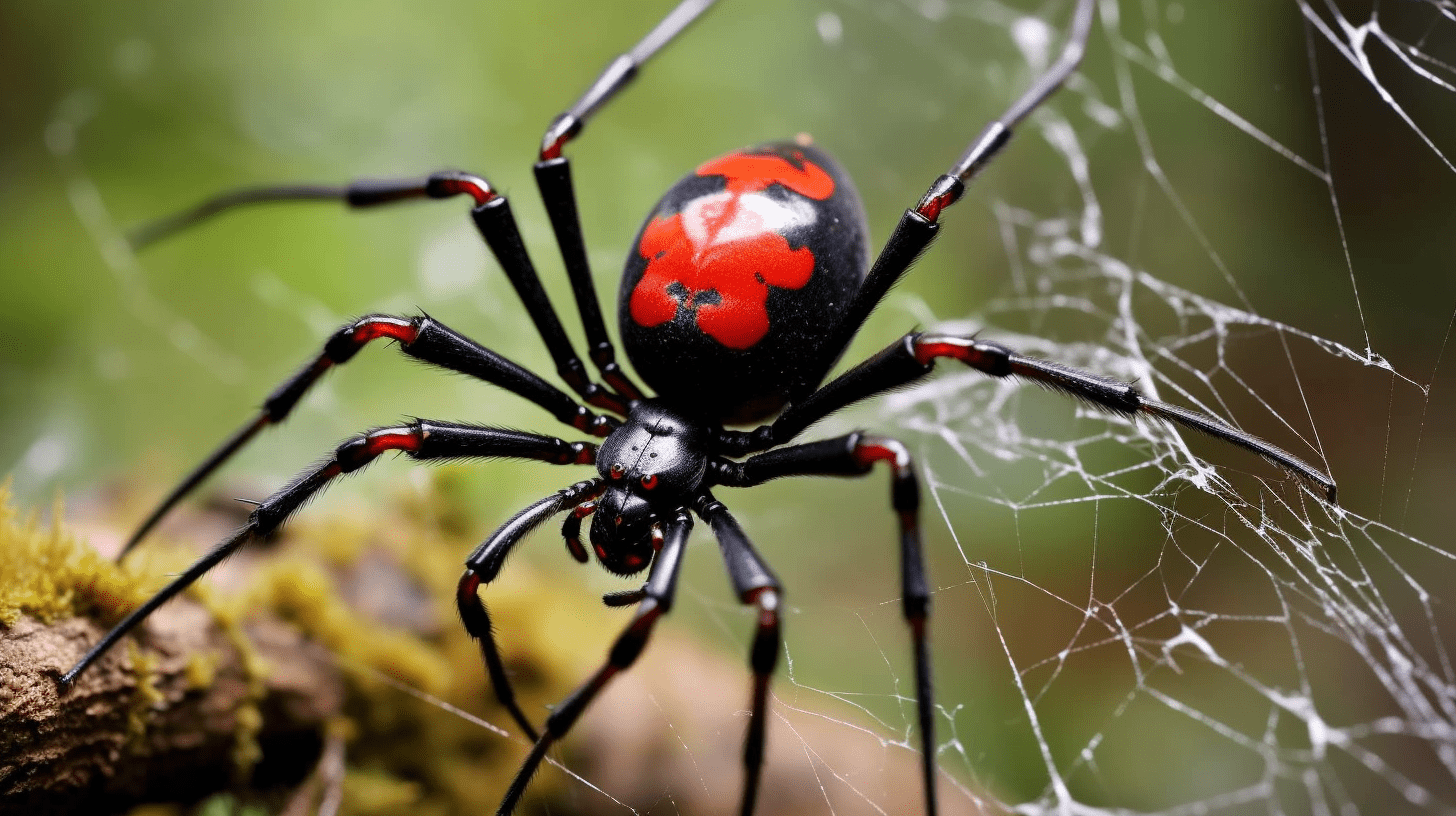
Coloration: Predominantly black with a notable red hourglass shape on the abdomen’s underside.
Proportions: They measure between 1 ½ and 1 3/8 inches in length.
Number of Legs: 8
Antennae: None
Body Configuration: Spherical body form.
Locale: A widespread presence throughout the United States.

Habitats and Distribution of Black Widows
A global presence, black widow spiders inhabit diverse environments across the world, preferring warmer climates. Their geographical distribution spans North America, particularly Florida.
Black widows typically weave their webs near ground level, in dark, undisturbed spaces like woodpiles, storage bins, or corners of garages. This preference makes human encounters with them possible, though not necessarily frequent.
Further exploring the environments of black widows, it’s worth mentioning that their habitats aren’t confined to the outdoors. They can also invade indoor areas, especially if these are cluttered and seldom used, offering them the secluded setting they crave. If you discover one in your space, remember the role of SpiderShield, your , long-lasting ally in keeping these unwanted visitors at bay.
The Life Cycle of Black Widows
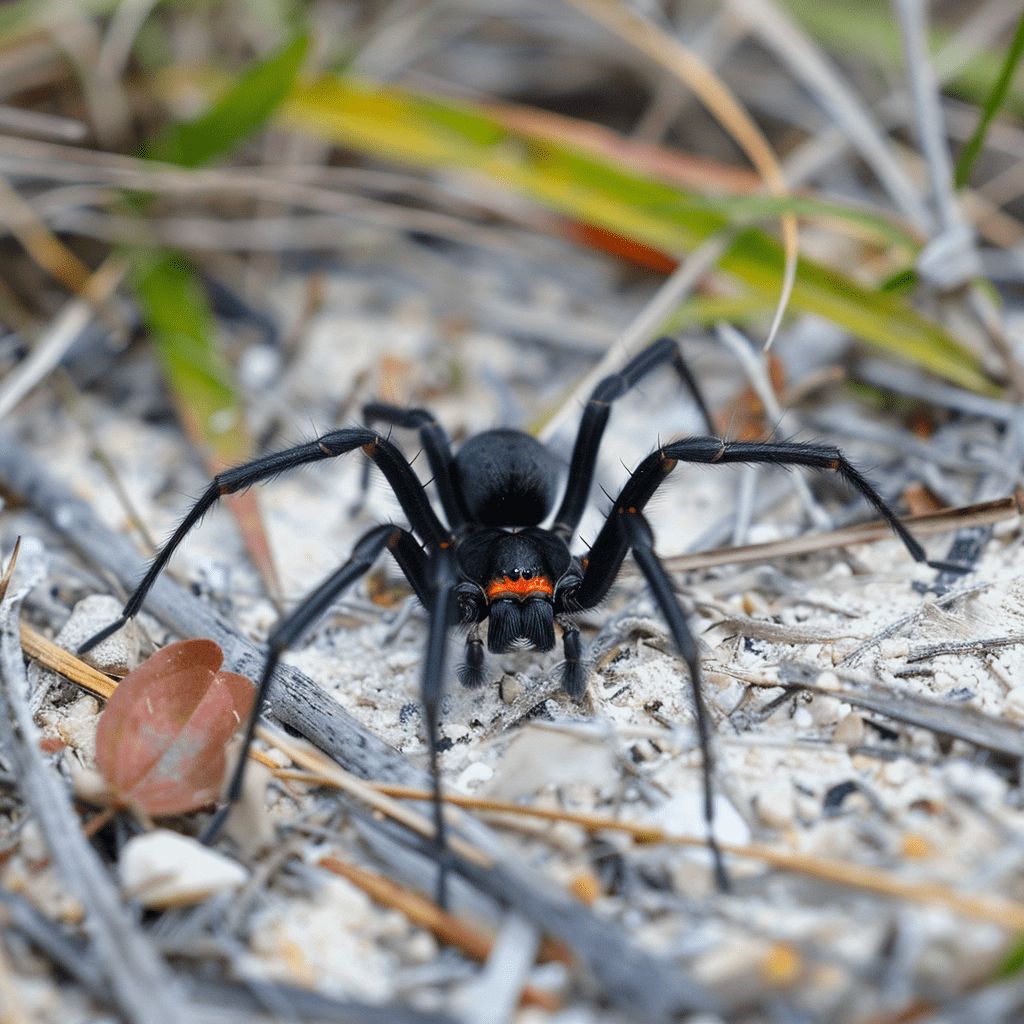
After getting introduced to black widow spiders, their physical characteristics, and the threats they pose, it’s essential to understand their life cycle. This section delves into two crucial aspects: their unique mating rituals and the survival chances of their offsprings.
Mating Rituals
Getting to know the mating rituals of black widow spiders provides an insight into their intriguing world. Usually, the male approaches the female, identified by her powerful pheromones. He performs a complex dance to attempt to earn her approval, the stakes being remarkably high. Failure, in this case, involves quite a literal death sentence, as the female sometimes eats the unsuccessful suitor.

Got Spider Issues? Get A Quote!
SCHEDULE FREE INSPECTIONOffspring Rearing and Survival
Post-mating, females lay about 100 to 300 eggs in the silk sacs they create. Survival isn’t a surety since these sacs often fall prey to parasitic insects. Eggs that do survive hatch into spiderlings. Intriguingly, these spiderlings weave ballooning silk threads, using the wind to disperse to new locations. But, their survival is still uncertain, considering the numerous threats they face. Even though these challenges, a single surviving female black widow can lay several more egg sacs, so continuing their species.
Understanding this life cycle forms the groundwork in comprehending their dwelling patterns and expanse, emphasizing SpiderShield’s role in protecting your spaces from potential invasions.
Myths and Misconceptions about Black Widows
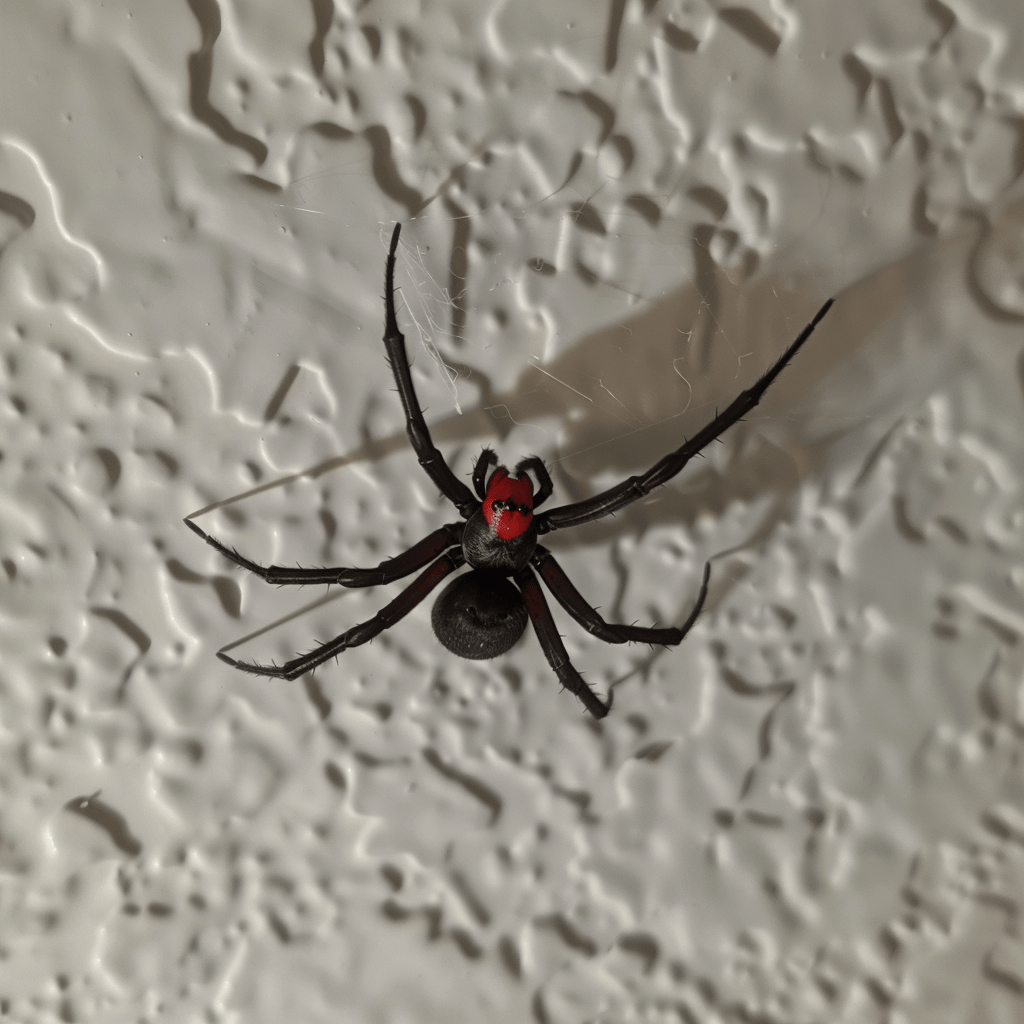
Unravel these myths and misconceptions to gain a realistic and accurate view of “black widow spiders.”
Debunking Fear and Misunderstanding
- Myth 1: Black Widow Spiders’ Bites are Often Fatal. The probability of a fatality from a black widow’s bite is less than it once was, primarily due to improved medical facilities and knowledge.
- Myth 2: All Black Widow Spiders are Female. In reality, both male and female black widow spiders exist. Yet, females are more renowned because of the distinctive red hourglass on their abdomen, superior size, and stronger venom.
- Myth 3: Black Widow Spiders are Aggressive. These spiders are generally shy, preferring solitude. They bite only when threatened, using their venom as a defense mechanism rather than an offensive tool.
Disliping these common myths can offer a more rational understanding of black widow spiders. In the process, it helps to eradicate ungrounded fear and promotes coexistence with these distinct creatures. Also, it emphasizes the role of remedies like ‘SpiderShield,’ which plays a part in responsibly managing these spiders.
Anatomy of a Black Widow Bite
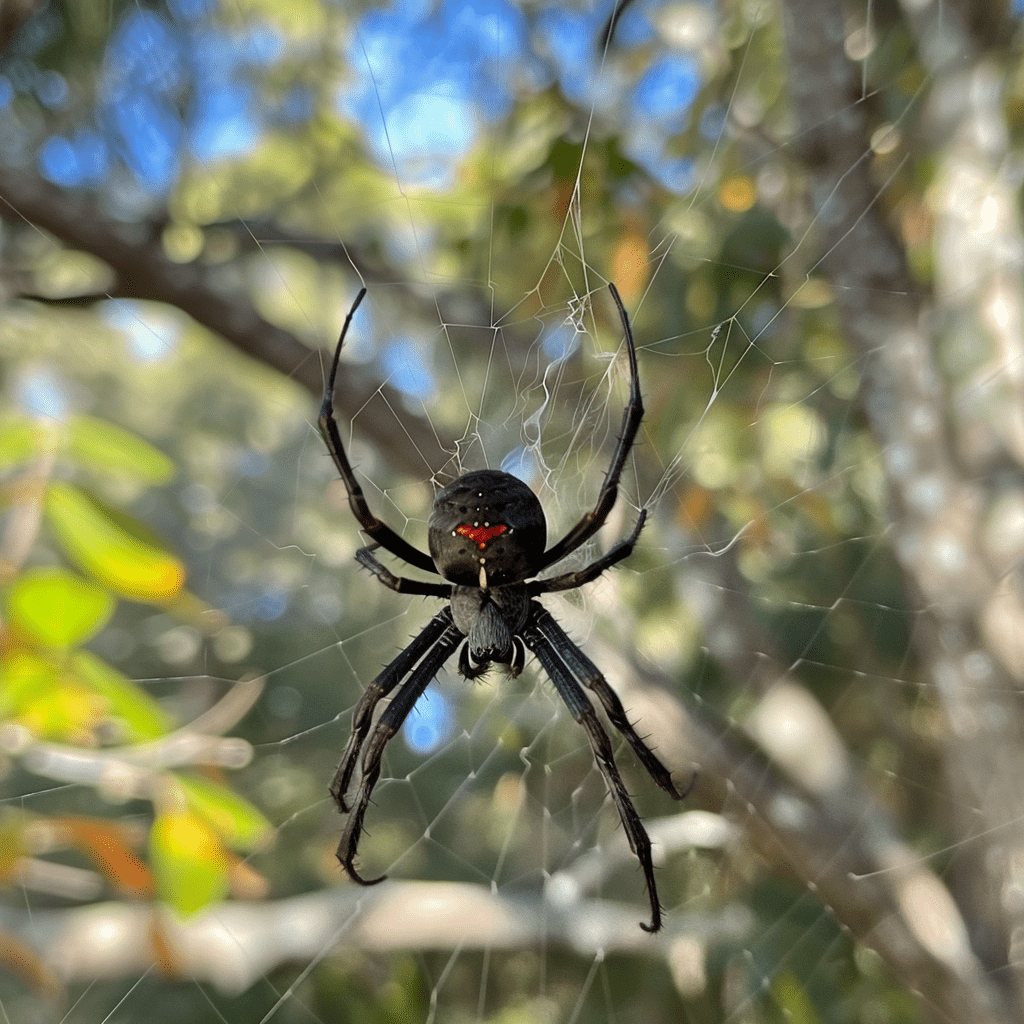
Delving deeper into the aspect of black widow spiders, one factor stands out — their venomous bite. Notorious in its reputation, yet grossly misunderstood, the bite of a black widow deserves close inspection. No longer seen as certain death sentence, comprehending its repercussions forms the next phase of our study.
Who is at Risk?
Everyone, to some extent, faces the risk of encountering a bite from black widow spiders. Yet, specific sections, due to lifestyle or environmental factors, exhibit higher susceptibility. First and foremost, people who dwell or work in regions known for prevalent black widow habitats come under the higher risk category. Bands of North America, Africa, Australia, and South America are noteworthy. Areas encompassing garages, woodpiles, basements are potential black widow realms.
Children, with their nascent immune system and extensive outdoor activities, fall under the risk zone. Similarly, the elderly, people with compromised immunity, pregnant women, and outdoor workers are vulnerable too. But, acts of provocation, consciously or unknowingly, are the primary cause behind black widow bites.
Treatment and Prevention
Treatment of a black widow bite leans heavily on the administration of antivenom. But, consult an expert observer like a doctor before resorting to it, as it links to potential allergic reactions. Pain management, a prominent part of the treatment process, takes help from over-the-counter pain relievers. Medical-grade muscle relaxants are another option if the pain persists.
Preventing a black widow bite revolves around staying vigilant in their dwelling zones. Regular checking of shoes, gloves, and outdoor gear can save you from unwelcome surprises. Safeguarding your home couldn’t do without SpiderShield, proving its indispensability in warding off black widow spiders. Clearing up clutter and maintaining cleanliness in garages, basements, and outdoor spaces are the first steps towards black widow- proofing your surroundings.
Remember, the key lies in responsible management and coexistence, not extermination. Through advanced understanding, mitigating the risks, and preventive solutions like SpiderShield, the fear surrounding black widow spiders can be managed effectively.
The Role of Black Widows in Ecosystems
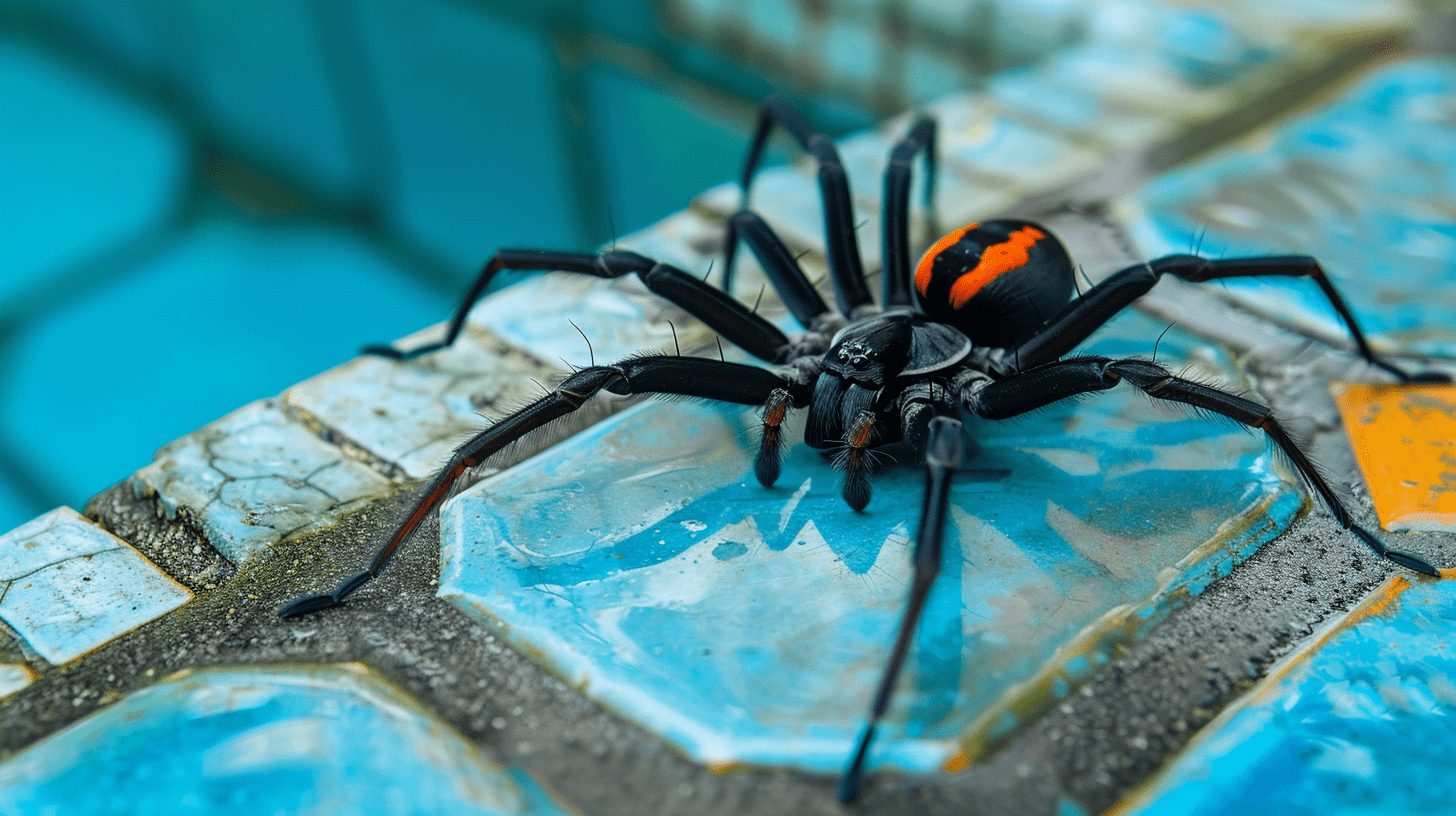
Moving beyond the fear factor, let’s explore the critical role that black widow spiders play within ecosystems.
Pest Control and Balance
You might find it hard to believe, but black widow spiders contribute immensely to maintaining ecosystem balance. Their feeding habits prominently include small insects, some of which are classified as pests, like beetles, crickets, and even cockroaches. In this way, they contribute to regulating the insect population, keeping it in check.
But that’s not all. Black widow spiders become a food source for other arachnids and insects, including ants, certain wasps, and even some birds. In this role, they support the survival of many organisms, reinforcing their crucial position in the food chain.
Pollination Support
Though not as commonly known, black widow spiders also assist in plant pollination. Occasionally, black widow spiders feast on small pollinators like flies but leave larger pollinators like bees unaffected. Their predatory activities, hence, can result in a more selective, efficient pollination process, favoring the survival of certain plant species.
Decomposition Helpers
Ever wondered what happens to those tiny insect carcasses? Black widow spiders, like other arachnids, play a crucial role in the decomposition of dead insects. By consuming these carcasses, they initiate the breakdown process that eventually enhances soil nutrients, highlighting another indirect support they provide to plant life in their habitats.
See, in the grand scheme of things, black widow spiders are more than a dangerous presence. They are essential cogs in the larger ecological machine. In short, black widow spiders are not only survivors but are also vital role players in their ecosystems.
The Relationship between Humans and Black Widows
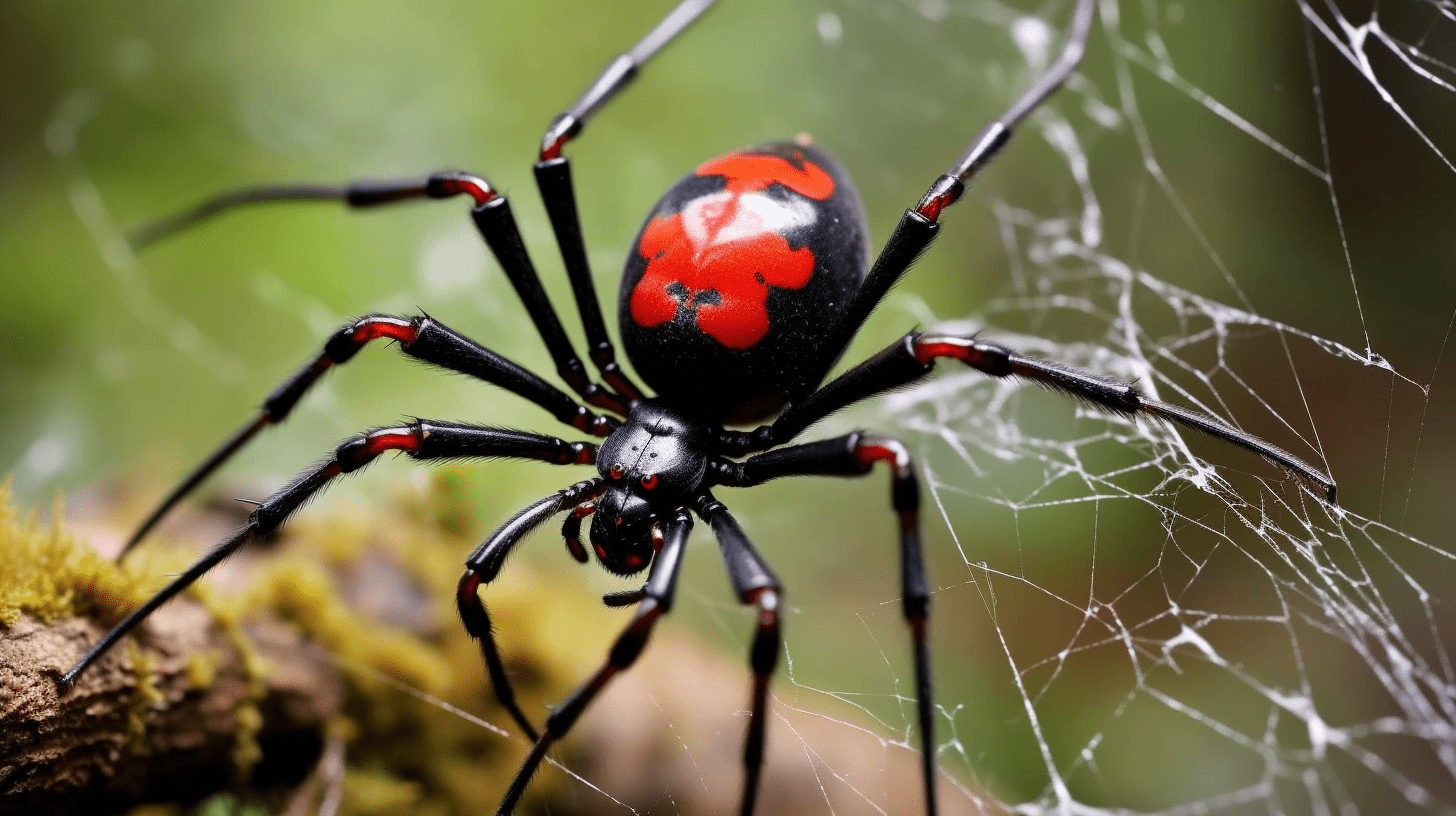
Encounters and Co-existence
Moving from the confines of the backyard to the boundaries of co-existence, let’s investigate into how humans cross paths with black widow spiders. These encounters, while initially intimidating, are more common than you might expect. Black widows, preferring low-traffic, secluded areas, wind up in garages, attics, and garden sheds, often leading to unexpected confrontations.

Got Spiders? Get A Quote!
SCHEDULE FREE INSPECTIONBut, black widows aren’t necessarily aggressive. They display defensive behavior only when disturbed, hence reducing surprise interactions minimizes the risk of bites. Hence, it’s all about mindfulness and respect. Recognize they’re part of the environment. So, exercise caution while approaching dark, quiet spaces, giving these creatures their space, ensuring your safety, and maintaining natural balance.
What transpires next presents a compelling duality – fear versus interest. It’s intriguing how these notorious spiders unwittingly make pivotal contributions to human life beyond their ecological roles.
Contribution to Research and Medicine
Black widow spiders, even though their infamy, offer valuable contributions, particularly in the area of research and medicine. Their venom constitutes a powerful neurotoxin called latrotoxin. This potent substance – while dangerous in unfavourable circumstances – exhibits promising medical implications by providing insights into nervous system functioning.
The venom of black widows has led to advancements in understanding how nerve cells communicate, forming the basis for research into conditions such as Alzheimer’s and epilepsy. Even though the utility of black widow venom for therapeutic applications is still under study, it paves the way for potential breakthroughs.
So, while the role of black widow spiders can send a chill down your spine, it’s captivating to realize how these creatures bulwark ecosystems, stimulate scientific exploration, and even kindle possibilities for medical advancement. The story of humans and black widows is so multifaceted, teetering between caution, co-existence, and potential collaboration.
Conservation Status of Black Widows
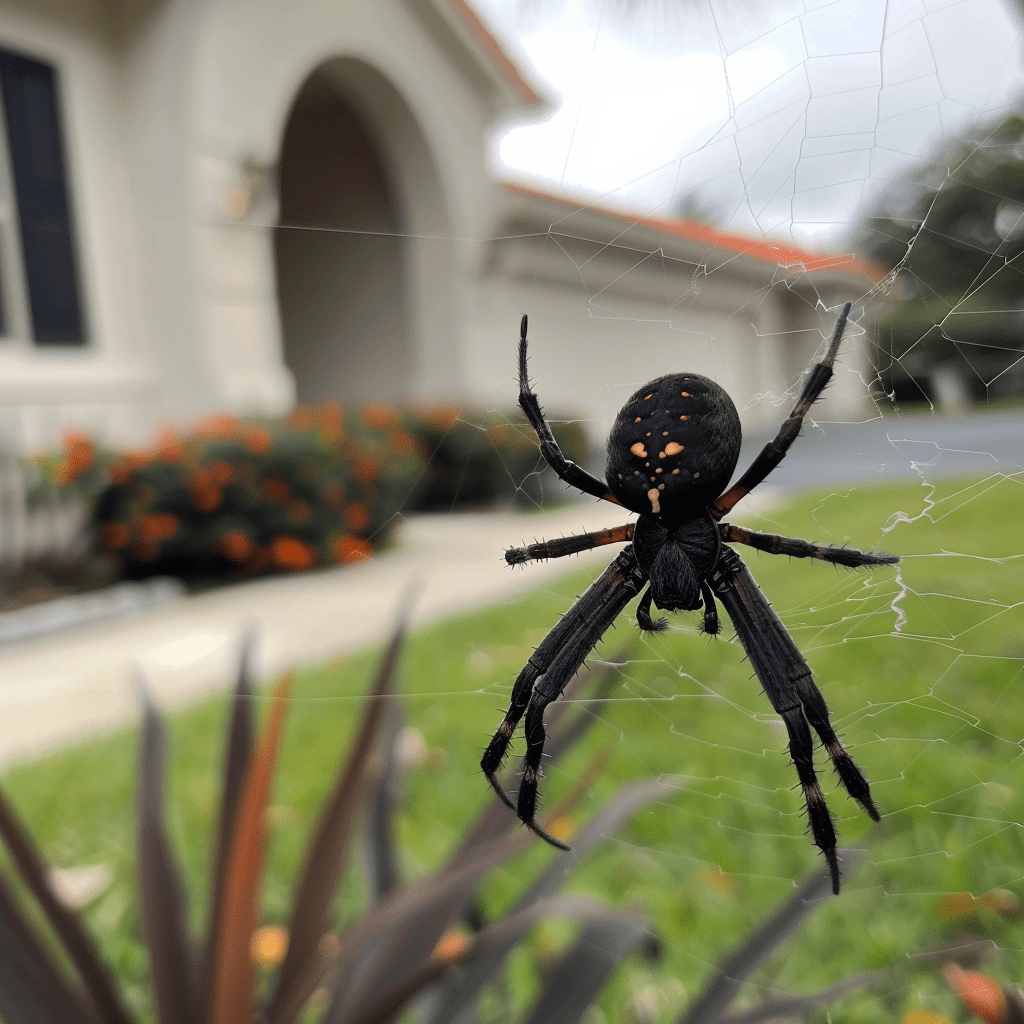
The preservation of black widow spiders, while not often a common topic, reflects their essential roles in ecosystems. Quantifying the species’ endangerment calls for exploration under the following subheading.
Threats and Protection Measures
Black widow spiders face significant challenges in the form of habitat loss, climatic changes, predator pressures, and human encounters. Habitat destruction is a primary factor to consider. As urbanization and agriculture expansion ensue, the natural dwellings of these spiders are gradually eroded. This results in a shrinking population and restriction to confined geographical regions.
Predator pressures, including birds, cats, and larger spiders, lead to a further reduction in numbers. Sudden climatic changes are too much of a jolt for these cold-blooded creatures, and often prove fatal.
Human encounters are a double-edged sword. While the presence of black widows poses risks to humans, these encounters also often end with either accidental destruction of the spiders’ habitat or their forced extermination.
To mitigate these issues, concerted efforts toward their protection are crucial. On a basic level, the careful management of habitats, such as minimizing yard waste, reducing the use of pesticides, and controlling habitat encroachment, can reduce the risks faced by both humans and the spiders.
Organizations like SpiderShield serve a dual purpose by not only keeping homes safe but also minimizing the chance encounters that usually end in human-induced mortality for the spiders.
Documented research endorses the significance of biodiversity conservation, considering all species. This includes not-so-popular creatures like black widow spiders. Meanwhile, more programs that promote the understanding and peaceful coexistence of humans and spiders are needed.
Awareness campaigns also play a part in dispelling myths and reducing unnecessary extermination. It’s important to continue the momentum of education and awareness, not just for the protection of black widows but for the stability of ecosystems at large.
Remember, black widows play a valuable role in maintaining ecological balance. Acknowledging this and adopting careful strategies hold the key to their survival.
Conclusion
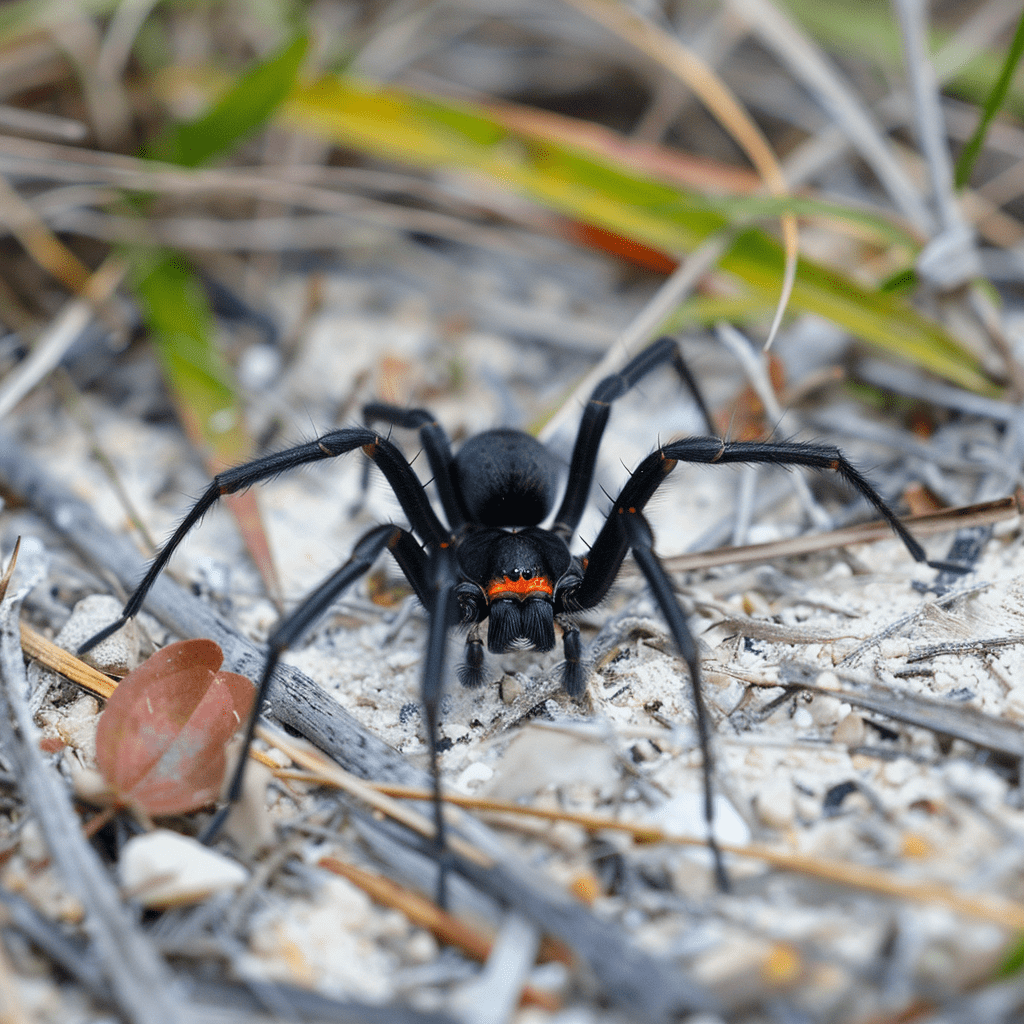
So, you’ve journeyed through the world of black widows, exploring their unique characteristics, dispelling myths, and understanding their role in ecosystems. You’ve learned about their potent venom, their mating rituals, and how SpiderShield can help keep your home safe. But remember, black widows aren’t just about danger and fear. They’re critical players in our ecosystems, controlling pests and contributing to decomposition.
Facing threats from habitat loss and climate change, these spiders need our help. It’s not about extermination, but about coexistence. By managing habitats, reducing pesticide use, and raising awareness, we can ensure their survival. After all, biodiversity is essential for a healthy planet. So, let’s move beyond fear, embrace SpiderShield for protection, and work towards peaceful coexistence with black widows. Because understanding and respect for these creatures is a step towards a balanced ecosystem.
FAQs
What is SpiderShield?
SpiderShield is a product from Waves Pest Control that is designed to help keep homes free of spiders. It is particularly effective against black widow spiders which are known for their strong venom and preference for dark, undisturbed spaces.
Where are black widow spiders commonly found?
Black widow spiders are distributed globally and they have impressive indoor invasion capabilities. They have a preference for dark, undisturbed spaces, and they pose a risk to homeowners around the world.
How dangerous are female black widow spiders?
Female black widow spiders pose a significant threat due to their potent venom. However, they usually only bite humans when they feel threatened or cornered.
What role do black widow spiders play in an ecosystem?
Black widow spiders play a critical role in their ecosystems. They help control other pest populations by feeding on insects like beetles and crickets. They also serve as food sources for other organisms and assist in plant pollination and decomposition processes.
What threatens the conservation status of black widow spiders?
Black widow spiders are threatened by habitat loss due to human encroachment, climate changes, predator pressures, and direct human encounters. An imbalance in any of these factors could severely impact their existence.
What measures are proposed to help conserve black widow spiders?
Protection measures include habitat management, reducing pesticide use, and promoting peaceful coexistence. Efforts are currently focused on raising awareness and educating people about the critical role and value these spiders hold in maintaining ecosystem stability.


